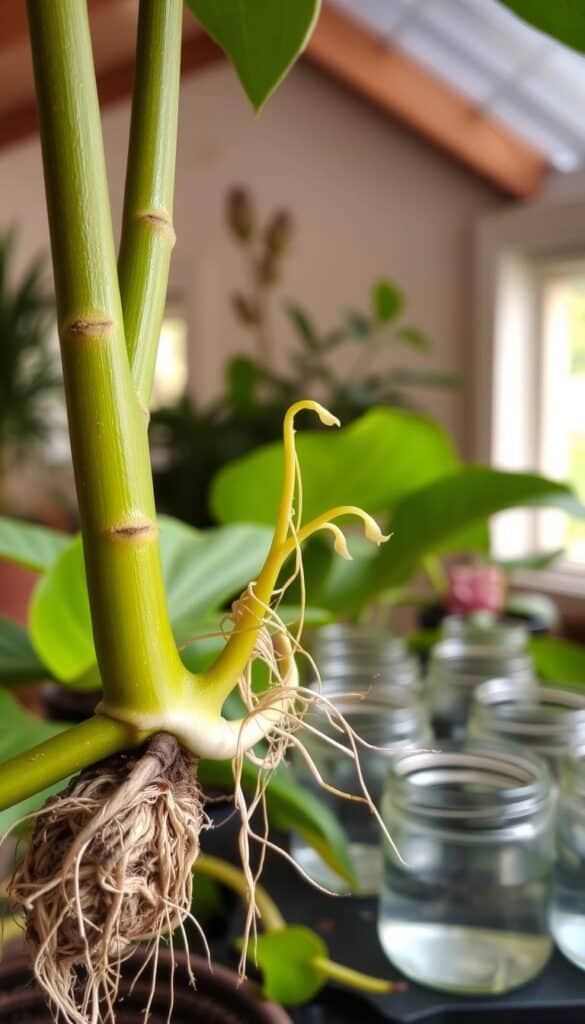Welcome to your ultimate guide to growing the stunning Philodendron Black Cardinal! This beautiful houseplant captivates with its unique foliage, which transforms from deep black to a striking cardinal red as it matures. Native to tropical regions, the Black Cardinal is a compact yet vibrant addition to any indoor space.
Understanding the specific needs of your Philodendron Black Cardinal is key to keeping it thriving. In this guide, we’ll walk you through everything from light and water requirements to propagation tips and troubleshooting common issues. Whether you’re a seasoned plant enthusiast or just starting your journey, this guide will provide you with the expert advice you need to succeed.
Get ready to dive into the world of this incredible plant and discover how to bring out its full potential. Let’s embark on this journey together and ensure your Philodendron Black Cardinal remains healthy, vibrant, and a standout piece in your home.
Welcome to My Journey with the Black Cardinal
My adventure with the Philodendron Black Cardinal began when I first laid eyes on its striking foliage at a local nursery. The deep, almost black leaves with hints of red captivated me, and I knew right then I had to bring it home. This plant quickly became more than just a decoration; it was a companion on my journey into the world of houseplants.
At first, I faced some challenges. I soon learned that finding the right spot was crucial. The Black Cardinal prefers bright, indirect light, and placing it near a window made all the difference. I noticed that even a slight change in window placement could affect its growth, teaching me the importance of observation and adaptability.
As I cared for my Philodendron, I discovered how lighting and location influence its behavior. It thrives in well-draining soil and a spot where it can receive ample light without direct sun. These observations highlighted the delicate balance needed to keep my plant healthy and vibrant.
I invite you to join me on this educational and heartfelt journey as we explore the ins and outs of nurturing the Philodendron Black Cardinal. Together, we’ll uncover the secrets to helping this stunning houseplant flourish in your home.
Essential “philodendron black cardinal care guide” for Thriving Houseplants
Creating the perfect environment for your Philodendron Black Cardinal involves understanding its specific needs. Light, temperature, and humidity are critical factors that directly impact its health and appearance. By mastering these elements, you can ensure your plant thrives and maintains its stunning foliage.
Understanding Light and Temperature Needs
Bright, indirect light is essential for the Philodendron Black Cardinal. Direct sunlight can scorch the leaves, so it’s best to place the plant near an east- or west-facing window. This balanced light exposure promotes healthy growth and vibrant leaf color.
Temperature is another vital factor. Keep your plant in an area with a consistent temperature above 65°F (18°C). Avoid placing it near drafts or air conditioning vents, as sudden temperature fluctuations can stress the plant.
Maintaining Proper Humidity Levels
Humidity is crucial for the Philodendron Black Cardinal. Aim for a humidity level of at least 60% to prevent fungal issues. You can achieve this by using a humidifier or placing the plant on a tray filled with water and pebbles.
- Bright, indirect light prevents leaf scorching and promotes vibrant color.
- Maintain a warm, stable temperature above 65°F to avoid stressing the plant.
- Ensure balanced light exposure to encourage healthy growth.
- Improper light and temperature can lead to dull leaves and stunted growth.
- Humidity levels over 60% are essential to prevent fungal issues.
Selecting the Perfect Spot and Creating the Ideal Potting Mix
Placing your Philodendron Black Cardinal in the right spot is crucial for its health. Look for a spot with bright, indirect light, as direct sunlight can scorch the leaves. A window with filtered sunlight is ideal.
Choosing the Right Location in Your Home
Near an east- or west-facing window is perfect. Avoid placing it in direct sunlight, especially during peak hours, to prevent leaf scorch. Keep it away from drafts and extreme temperatures.
Crafting a Well-Draining Potting Mix
A well-draining mix is essential to prevent root rot. I recommend a DIY mix of potting soil, perlite, and orchid bark in equal parts. This mix ensures proper drainage and aeration.
| Ingredient | Benefits |
|---|---|
| Potting Soil | Rich in nutrients, supports healthy root growth. |
| Perlite | Improves drainage, prevents waterlogging. |
| Orchid Bark | Enhances aeration, supports root health. |

The right spot and mix work together to keep your plant vibrant. Proper light and drainage ensure your Philodendron Black Cardinal thrives.
Watering and Fertilizing: Nurturing Your Plant’s Growth
Proper watering and fertilizing are essential for keeping your Philodendron Black Cardinal healthy and vibrant. These practices ensure your plant gets the right amount of nutrients to thrive.
Mastering the Watering Routine
Instead of following a strict schedule, check the soil moisture by inserting your finger into the soil up to the first knuckle. Water only when the top 2-3 inches of soil feel dry. This method prevents overwatering, which can harm the roots.
A good routine is to water your plant once a week during the growing season. Adjust this based on your home’s humidity and temperature. Always use room-temperature water to avoid shocking the roots.
Feeding Techniques for Lush Foliage
During the growing season (spring-fall), feed your plant with a half-strength, high-nitrogen fertilizer. Dilute the fertilizer to avoid burning the roots. Apply it every 4-6 weeks for optimal nutrient intake.
Avoid over-fertilizing, as it can cause leaf discoloration. If you notice leaves turning yellow or brown, it might be a sign of too many nutrients.
Consistent care is key to promoting steady growth. By following these watering and fertilizing tips, you’ll help your Philodendron Black Cardinal maintain its stunning appearance and thrive in your home.
Pruning, Propagation, and Routine Maintenance
Maintaining your Philodendron Black Cardinal is key to its beauty and health. Regular pruning and propagation can keep your plant vibrant and thriving. Let’s dive into some practical steps to help you master these techniques.
Simple Pruning Tips to Encourage New Growth
Pruning is essential for removing dead or damaged leaves and promoting healthy growth. Here are some tips:
- Use clean, sharp tools to prevent spreading diseases.
- Remove dead or yellowing leaves to prevent pests and diseases.
- Trim back overgrown stems to maintain shape and encourage new growth.
Propagating the Black Cardinal from Stem Cuttings
Propagating your Philodendron Black Cardinal is a great way to share plants with friends or expand your collection. Here’s how:
- Choose a healthy stem with at least two nodes.
- Cut the stem just below a node using sterile tools.
- Allow the cutting to callus for 24-48 hours to reduce rot risk.
- Place the cutting in water, ensuring the node is submerged.
- Roots should develop within 1-2 weeks; transplant to soil when roots are strong.
| Method | Pros | Cons |
|---|---|---|
| Water Propagation | Easy to monitor roots; high success rate. | Can be messy; requires frequent water changes. |
| Soil Propagation | Quick establishment; less maintenance. | Harder to monitor root development. |
| Air Layering | High success rate; minimal plant stress. | More complex; requires careful layering. |

By following these steps, you can successfully propagate your Philodendron Black Cardinal and keep it healthy with regular maintenance. Happy planting!
Troubleshooting: Recognizing and Resolving Plant Stress
Every plant parent knows that sometimes, even with the best care, things can go wrong. If your Philodendron Black Cardinal is showing signs of stress, it’s important to act quickly to prevent further damage.
Identifying Signs of Overwatering and Underwatering
Yellowing leaves can be a sign of overwatering, while droopy stems may indicate the soil is too dry. If the leaves turn brown, it might be underwatering. Check the soil moisture by sticking your finger into the soil up to the first knuckle. Water only when the top inch of soil feels dry.
Managing Pests and Fungal Issues
Common pests like mealybugs can be treated with neem oil. For fungal issues, ensure good airflow and avoid overwatering. Regular monitoring is key to catching problems early.
| Issue | Symptoms | Solution |
|---|---|---|
| Overwatering | Yellow or soft leaves | Stop watering until soil dries |
| Underwatering | Brown edges or wilted stems | Water thoroughly, check daily |
| Pests | White spots or sticky residue | Apply neem oil, isolate plant |
By staying alert and taking prompt action, you can help your Philodendron Black Cardinal recover and thrive.
Optimizing the Environment: Adjusting Light, Temperature, and Airflow
Creating an ideal environment for your plant is crucial for its health. The right balance of light, temperature, and airflow can make all the difference in keeping it thriving.
Lighting plays a significant role. Position your plant near a window with filtered sunlight, avoiding direct rays that can scorch the leaves. East- or west-facing windows are perfect spots.
Maintaining stable temperatures is equally important. Keep your plant in an area with temperatures above 65°F to prevent stress. Avoid placing it near drafts or air conditioning vents, as sudden changes can be harmful.
Humidity levels should also be considered. If your home is dry, using a humidifier can help maintain the right moisture. Grouping tropical plants together is another effective way to create a humid microclimate.
- Place the plant near a window with filtered sunlight.
- Maintain a consistent temperature above 65°F.
- Use a humidifier in dry environments.
- Group tropical plants to increase humidity naturally.
By fine-tuning these environmental factors, you can create a balanced and nurturing space for your plant to flourish. Proper drainage, achieved by using perlite in the soil, enhances root health and prevents waterlogging. Ensuring good airflow helps combat humidity-related issues and reduces the risk of fungal problems. Regular monitoring and adjustments will support long-term growth and vitality, making your plant a vibrant addition to your home.
Final Reflections on Caring for Your Philodendron Black Cardinal
Reflecting on my journey with the Philodendron Black Cardinal, I’ve learned that its vibrant transformation from deep hues to striking reds is a testament to the impact of attentive care. This plant thrives on consistency, making it a perfect companion for both new and experienced plant enthusiasts.
To ensure your Black Cardinal flourishes, remember a few key tips. Water when the top inch of soil feels dry, and use a well-draining potting mix to prevent root issues. Place it near a window with filtered light, avoiding direct sun, and maintain a humid environment, ideally above 60%.
Regular pruning and occasional fertilization during the growing season will keep your plant robust. By adapting these practices to your home, you’ll enjoy a healthy, thriving Black Cardinal that adds beauty to your space.
With patience and consistency, nurturing this plant becomes a rewarding experience. Share your progress and the joy of plant care with others, and happy planting!
